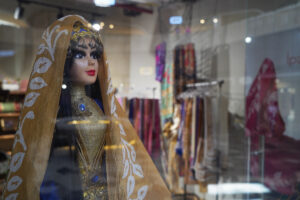Azerbaijan, as the gateway between mysterious China and Europe since the ancient period of the Great Silk Road, has a long history of trading culture. One of the old traditions that has survived through the ages is the oriental bazaar, reflecting the identity and cultural code of the nation. The history of Sharg Bazaar [Ed. note: Sharg means Eastern in Azerbaijani] in Baku dates back to 1980. Its building was constructed in line with the Soviet modernism style of that time. In 2022, the visitors saw it in a completely new form after its reconstruction that has artfully combined a modern approach with the cultural heritage of the past.
At Sharg Bazaar you can get lost in the smell of spices, the range of products on offer, and the alluring speech of the vendors. It’s hard to resist! Everyone will find something to their liking here. National carpets, jewelry shops, locally produced fruit and vegetables, spices and herbs, art studios, modern kitchenware, Azerbaijani modernist teahouse – Chayxana and restaurants’ terraces with a variety of national dishes – as many as 78 shops spread over various sections under the 16 domes of the Bazaar Complex. Fuad Ibrahimov, PR Manager of the shopping complex, tells us about the historical path and distinctive atmosphere of Sharg Bazaar.
BY SALATYN MIRZAYEVA
AZERI OBSERVER STAFF WRITER
Question: Sharg Bazaar is regaining its former popularity and affection. Can you share the history of this cultural monument reflecting ancient oriental traditions in Azerbaijan?
Answer: Architects started working on the design of Sharg Bazaar in 1978. When the construction work was completed in the 1980s, it opened its doors to visitors and within a short period of time became a favourite place of the residents of the capital. In 1982, the inauguration of this monument was attended personally by a great son of Azerbaijan, Heydar Aliyev. Sharg Bazaar has been designed by renowned architects Uruzmag Revazov, Pavel Yarinovsky and Anatoly Bessonov. They planned to design it as a complex consisting of 16 domes – 3 large and 13 small. This was indeed a unique project, which was nominated for the Aga Khan architectural award for the first time in the history of Azerbaijan. It was the biggest award in the entire East. In 2001 the Azerbaijani Cabinet of Ministers included Sharg Bazaar in the state register of the immovable historical and cultural monuments of local importance. Unfortunately, in 2017, the badly deteriorated shopping complex was recognized as unusable and requiring renovation. The building had serious damage, and suffered from corrosion and deformation caused by improper use and poor maintenance.
Q.: Tell us about the newly modernised concept of Sharg Bazaar. What changes were done during the renovation?
A.: During the restoration and renovation works in the complex, special attention was paid to preserving the original concept and special elements. The number and shape of the small and large domes have been fully preserved. What was changed is the connection of the main domes with a covered courtyard. Here the upper storey acquired the form of an innovative style glass bridge. It is worth mentioning that locally produced materials were mainly used in the reconstruction. As for the concept, it uses a synthesis of modern design with national ornaments, carpet patterns, and other traditional elements. The modernisation of the complex also envisaged the introduction of new technology, equipment, and security systems. For example, all large domes are lit by hand-made chandeliers with innovative technologies. When the lights are on, they make a shadow of the traditional Azerbaijani shebeke pattern on the ceiling. Even the name of the bazaar at the entrance in Latin script which replaced the one engraved in Cyrillic script in the 1980s keeps the original calligraphy. At the opening ceremony, Azerbaijani President Ilham Aliyev and First Lady Mehriban Aliyeva were personally acquainted with the conditions created in Sharg Bazaar. Today the restored shopping complex in the oriental style is welcoming guests again. We have already received positive feedback from the residents of the capital on the return of the Eastern Bazaar tradition.
 Mr. Fuad Ibrahimov
Mr. Fuad Ibrahimov
Q.: How did the idea of gathering Azerbaijani brands in Sharg Bazaar and collaborating with local artisans appear?
A.: Made in Azerbaijan is a phrase that is gaining more weight and power with each new day. This is not just some words, but a real sign that Azerbaijan produces more and more sought-after goods of quality. Craftsmen create original items, which we use in everyday life with great pleasure and pride. After all, these products are the result of the hard work of talented Azerbaijani craftsmen. Now when we show the beauties, achievements, and landmarks of our country to foreign guests, we can mention not only national dishes, monuments and literature, but also demonstrate artworks of our contemporary artists.
Q.: What local brands do you work with? Are there any special requirements for tenants of Sharg Bazaar’s commercial spaces?
A.: Under a dome called «Emalatxana» (Workshop), there are studios of talented carpet weavers, potters, handkerchief makers, and soap-makers. Small workshops have also been set up in the bazaar for them. The area under the next dome is reserved for restaurants and cafes with a wide assortment of Azerbaijani, Asian and Turkish dishes. Moreover, you can buy various sweets, spices, dried fruits, wines, fresh vegetables and fruits there. In Sharg Bazaar you can also visit boutiques featuring various jewelery, antiques, unusual shawls with national ornaments and symbols of Karabakh, souvenirs, and much more.

Q.: This is a truly unusual format. Visitors can not only buy goods but also meet the artisans and see the creative process in their workshops. What artisans can we meet there for example?
A.: You can meet Eduard Shamoryaev – a jeweler who collects ancient Azerbaijani jewelery pieces and then improves their design to create distinctive pieces that you will want to wear. Gunay Mammadbeyli’s workshop presents hand-made hygiene products. These products consist of natural components, like various oils (essential oil, argan oil, rose oil, lavender oil) and even silk proteins.
It is definitely impossible to imagine the East without the traditional applied art of carpet weaving! The studio of the famous artist Eldar Hajiyev demonstrates this art. The master has developed an individual approach to his craft. The pattern he creates is transferred to the carpet, with a mixed technique using silk and wool threads. The works devoted to the victory of Azerbaijan in the Patriotic War and the tolerance of Azerbaijanis are particularly worth mentioning. The Emalatxana section also features one of the oldest decorating techniques, intarsia. The creator of these works is Jabrail Guliyev, who is considered the only artist in Azerbaijan to ace this craftsmanship. He creates his artworks from small wood chips without the use of paint. Pottery workshops and Tabriz-style miniatures complement the broad profile of the national crafts.
Q.: Who are the visitors to Sharg Bazaar today? Are foreign guests interested in its concept?
A.: Sharg Bazaar is a place that has been a symbol, a beacon of Baku for many years. Restored to integrate two opposing concepts of a typical market and a modern shopping mall, Sharg Bazaar is becoming a landmark, and everyone who wants to feel the zest of Azerbaijan’s oriental culture needs to visit this beautiful place. Obviously, the ‘must-see’ status is the main driver for attracting the flow of foreign visitors and tourists. Local people also show a great interest in the bazaar. The large flow of visitors is driven by colourful fairs, thematic workshops, festivals, and catering. I am sure that with each passing day, Sharg Bazaar will further enrich and diversify the life of our country.



























